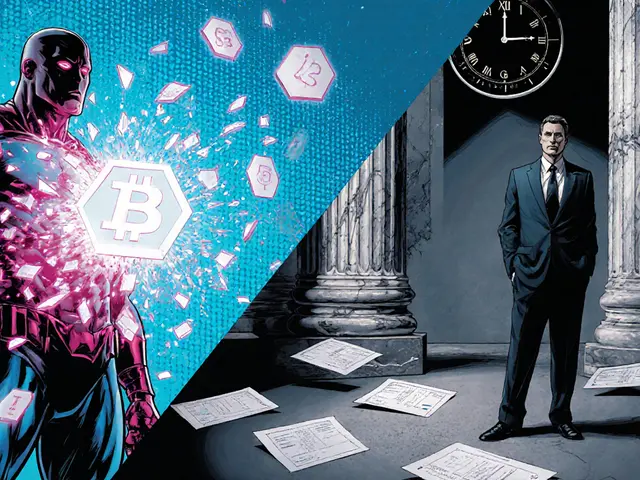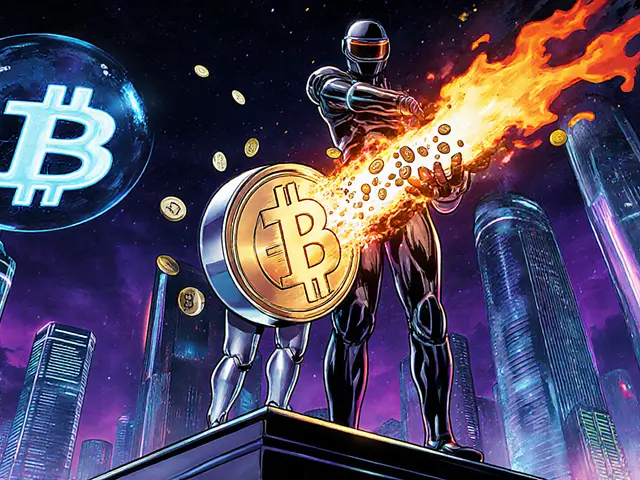Security Tokens vs Traditional Securities Comparison Tool
Security Tokens
Blockchain-based digital representations of real-world assets with smart contract automation.
Traditional Securities
Established financial instruments issued through legacy clearing houses and paper/electronic registries.
Core Attribute Comparison
| Attribute | Security Tokens | Traditional Securities |
|---|---|---|
| Settlement Time | Near-instant (minutes to hours) | 1-3 business days (T+2) |
| Liquidity | Enhanced via fractional ownership and 24/7 market access | Limited, especially for private placements |
| Fractionalization | Native-assets can be split into thousands of tokens | Generally not possible without creating separate share classes |
| Automation | Smart-contract-driven dividend distribution, compliance checks, and corporate actions | Manual processing, broker-mediated settlements |
| Regulatory Framework | Subject to securities law; compliance encoded on-chain | Well-established, but tied to legacy processes |
Benefits of Security Tokens
- Near-instant settlement
- Enhanced liquidity
- Native fractional ownership
- Automated compliance
- 24/7 market access
Benefits of Traditional Securities
- Mature regulatory framework
- Established market infrastructure
- Predictable processes
- Well-known settlement procedures
- Strong investor protection
Key Insight
Both security tokens and traditional securities are subject to the same legal tests for classification as securities, but security tokens leverage blockchain technology for enhanced efficiency, transparency, and automation.
Quick Takeaways
- Security tokens are blockchain‑based digital representations of real‑world assets.
- Traditional securities rely on legacy clearing houses and paper‑or‑electronic registries.
- Smart‑contract logic lets security tokens automate dividend payouts, compliance checks, and ownership transfers.
- Fractional ownership opens high‑value assets to everyday investors, boosting market liquidity.
- Regulatory exposure is similar, but implementation costs and settlement speed differ dramatically.
What Are Security Tokens?
When we talk about Security tokens are digital assets that represent a legal share, bond, or other entitlement in a real‑world asset and are built on blockchain technology, we’re looking at a new class of financial instruments that blend traditional securities law with crypto‑grade transparency.
Because each token lives on an immutable ledger, ownership, transfer history, and corporate actions are recorded automatically. For example, a tokenized real‑estate share can be split into 10,000 units, letting a $5,000 investor buy a tiny slice of a commercial building that would otherwise be out of reach.
The programmable nature of security tokens means that any rule-whether it’s a Know‑Your‑Customer (KYC) filter or a dividend schedule-can be hard‑coded into the token’s smart contract. This eliminates the need for manual paperwork after the initial issuance.
What Are Traditional Securities?
Traditional securities are financial instruments such as stocks, bonds, or mutual‑fund shares that represent ownership or debt and are issued, cleared, and settled through established market infrastructures. They have been the backbone of capital markets for over a century.
These instruments depend on centralized registries, clearing houses, and custodians. When a share changes hands, the transfer is recorded in a central ledger that can take one to three business days to settle (the so‑called T+2 cycle).
While the regulatory framework for traditional securities is mature and predictable, the processes are often heavy on paperwork, costly intermediaries, and opaque record‑keeping.
Technical Architecture: Blockchain vs Legacy Systems
The core difference lies in the underlying technology stack. Blockchain is a distributed ledger that stores data across a network of nodes, ensuring immutability, transparency, and consensus without a central authority. Security tokens inherit this architecture, meaning every transaction is cryptographically signed and permanently archived.
In contrast, legacy systems rely on centralized databases maintained by custodians and clearing houses. These databases are susceptible to single‑point failures, manual reconciliation, and delayed reporting.
Smart contracts-self‑executing code on the blockchain-act as the “brain” of security tokens. They can automatically enforce eligibility rules, calculate and disburse dividends, or even trigger token buy‑backs based on predefined triggers, something that would require a team of lawyers and accountants in a traditional setup.
Benefits Comparison: Automation, Transparency, and Fractionalization
| Attribute | Security Tokens | Traditional Securities |
|---|---|---|
| Settlement Time | Near‑instant (minutes to hours) | 1‑3 business days (T+2) |
| Liquidity | Enhanced via fractional ownership and 24/7 market access | Limited, especially for private placements |
| Fractionalization | Native-assets can be split into thousands of tokens | Generally not possible without creating separate share classes |
| Automation | Smart‑contract‑driven dividend distribution, compliance checks, and corporate actions | Manual processing, broker‑mediated settlements |
| Regulatory Framework | Subject to securities law; compliance encoded on‑chain | Well‑established, but tied to legacy processes |
The table illustrates why investors increasingly view security tokens as a more efficient vehicle for accessing assets that were previously illiquid or reserved for institutions.

Regulatory Landscape: Same Rules, Different Execution
Both security tokens and traditional securities must satisfy the same legal tests-like the Howey Test in the United States-to be classified as securities. However, Regulatory compliance is the process of ensuring financial products meet jurisdictional securities, anti‑money‑laundering, and investor‑protection requirements can be baked directly into the token’s code.
This on‑chain compliance means that a token can automatically block a transfer to an investor who fails an AML check, whereas a traditional share would require a broker to manually verify the buyer’s credentials before the trade clears.
Regulators are gradually issuing guidance that acknowledges the equivalence of security tokens to conventional securities, reducing legal uncertainty while still demanding transparent reporting and audit trails.
Market Liquidity & Access: Opening Doors for New Investors
One of the most compelling arguments for security tokens is their ability to democratize access. By tokenizing a private‑equity fund, the manager can sell 1% ownership slices to dozens of accredited investors rather than a single institutional buyer.
Because tokens trade on blockchain‑based exchanges-often 24/7-they enjoy a level of secondary‑market liquidity that traditional private‑placement securities lack. In addition, DeFi protocols can lend against tokenized assets, further expanding capital‑efficiency options.
Still, liquidity depends on market depth and the presence of reputable token‑trading platforms. Institutional adoption in 2024‑2025 has begun to create order books that rival those of niche private‑market brokers.
Implementation Complexity: Technology vs Infrastructure
Issuing security tokens requires a suite of technical components: a blockchain network (public or permissioned), smart‑contract development, token standards (like ERC‑1400), and a digital‑wallet solution for holders. This creates a higher upfront barrier for issuers compared to filing a prospectus for a conventional share offering.
On the flip side, once the token infrastructure is in place, transaction costs can drop dramatically because intermediaries-custodians, clearing houses, and settlement agents-are either removed or their roles are reduced to “verification nodes.”
Traditional securities benefit from a frictionless, well‑known process for issuers, but they still incur ongoing fees for custodial services, transfer agents, and exchange listings.
Future Outlook: Convergence, Not Replacement
Most industry analysts agree that security tokens will coexist with traditional securities rather than erase them overnight. Expect a hybrid model where large public companies continue issuing classic shares while simultaneously offering tokenized versions for global, 24‑hour trading.
Regulatory bodies are drafting token‑specific compliance frameworks, and major financial institutions are launching token‑custody services to bridge the gap for conservative investors.
In the next five years, we’ll likely see a surge in tokenized real‑estate funds, private‑equity pools, and even municipal bonds, all governed by the same securities laws that protect investors today-only now the process is faster, cheaper, and more transparent.
Key Takeaways for Different Personas
- Investor: Look for tokenized assets that offer fractional ownership and 24/7 liquidity, but verify that the issuer follows recognized compliance standards.
- Issuer: Weigh the upfront tech cost against long‑term savings on settlement fees and broadened investor reach.
- Regulator: Focus on ensuring that on‑chain compliance logic aligns with existing securities law while fostering innovation.
Frequently Asked Questions
Are security tokens considered securities under the law?
Yes. Most jurisdictions apply the same tests-like the Howey Test in the U.S.-to determine if a token is a security. If the token gives investors a right to profits derived from the efforts of others, it falls under securities regulation.
How does settlement time differ between the two?
Security tokens can settle in minutes or hours because the transfer is recorded on the blockchain instantly. Traditional securities follow a T+2 (or sometimes T+3) settlement cycle, meaning the buyer receives the asset two business days after the trade.
Can I earn dividends from a security token?
Yes. Smart contracts can be programmed to distribute dividends automatically based on profit declarations. The token holder receives the payout directly into their wallet without a broker’s mediation.
Is fractional ownership possible with traditional securities?
Not in the same native way. Traditional assets can be split through mechanisms like mutual funds or ADRs, but those structures require additional layers and often cannot achieve the same granularity as tokenization.
What are the main risks of investing in security tokens?
Key risks include regulatory uncertainty in some jurisdictions, reliance on the underlying blockchain’s security, potential smart‑contract bugs, and limited secondary‑market depth for certain tokenized assets.





Shelley Arenson
June 21 2025Security tokens are really shaking up the market, offering near‑instant settlement and 24/7 trading 🌐🚀. The ability to fractionally own high‑value assets means more people can hop on board without needing massive capital. Plus, smart contracts automate compliance, so the paperwork headache is dramatically reduced. It’s a win‑win for both issuers and investors, and the transparency of blockchain adds an extra layer of trust. 😊
Joel Poncz
June 22 2025i totally feel u on that, security tokens really make it easier for regular folks to get in on the action, i think its a big step forward even if the tech can be kinda confusing sometimes lol
Kris Roberts
June 23 2025When we look beyond the surface of tokenization, we see a profound shift in how value is distributed across society. The core idea of fractional ownership is not new, but blockchain gives it a frictionless, immutable backbone that traditional registries lack. Imagine a small investor holding a slice of a commercial building, a piece of an art collection, or even a share of a startup, all recorded on a public ledger that anyone can audit. This democratization challenges the historic gatekeeping role of big banks and custodians, which have traditionally decided who gets access. In practice, it means that capital can flow more freely, potentially spurring innovation in sectors that were previously under‑funded. The near‑instant settlement also reduces counter‑party risk, as the transfer of ownership is confirmed in minutes rather than days. Moreover, smart‑contract‑driven compliance can enforce KYC/AML rules automatically, shrinking the compliance cost curve for issuers. From a macro perspective, this could lead to more resilient markets, because diversification becomes easier when investors can hold tiny fractions of many assets. The psychological impact shouldn’t be ignored either; seeing your wallet update in real time can increase engagement and financial literacy. Critics argue that the technology is still nascent, but history shows that once infrastructure matures, adoption accelerates dramatically. Regulation will play a crucial role, yet the fact that security tokens are still subject to existing securities laws offers a familiar legal safety net. As more custodial solutions and regulated exchanges emerge, liquidity will improve, addressing one of the main concerns today. Finally, the environmental debate around blockchain is being tackled with greener consensus mechanisms, making the sustainability argument less of a blocker. In sum, the convergence of finance and decentralized tech is reshaping the landscape, and security tokens sit at the heart of this transformation.
lalit g
June 23 2025the points you raise are quite insightful, i agree that the technology holds promise while also acknowledging the current limits, especially regarding liquidity and regulatory clarity, which will likely evolve over time
Reid Priddy
June 24 2025while everyone is busy shouting about the benefits, they conveniently ignore the fact that these tokens could become a playground for market manipulation, that the underlying blockchain security is not bullet‑proof, and that regulators are still scrambling to understand the implications, which makes me wary of the hype surrounding them
Shamalama Dee
June 24 2025Security tokens indeed introduce new vectors of risk, however the programmable compliance mechanisms can mitigate many of those concerns when properly implemented. By embedding KYC/AML checks directly into the token logic, issuers can enforce regulatory standards without relying on external intermediaries. Additionally, ongoing audits of smart‑contract code, combined with insurance products, can address security vulnerabilities. It's essential for stakeholders to adopt best practices and maintain transparency to build trust in this evolving ecosystem.
Dyeshanae Navarro
June 25 2025Remember, every big financial breakthrough started as a niche idea. Keep your eyes on the long‑term benefits of access and empowerment that tokenization can bring to everyday investors.
Matt Potter
June 25 2025Bring that energy! Dive into token projects now, stake your claim, and watch the future unfold-no more waiting on slow legacy systems.
Marli Ramos
June 26 2025cool idea 😂
Christina Lombardi-Somaschini
June 27 2025In considering the comparative advantages of security tokens versus traditional securities, it is essential to acknowledge not only the technological efficiencies but also the regulatory continuity that underpins investor confidence; consequently, the integration of blockchain‑based assets must be approached with both optimism and prudence, ensuring that compliance frameworks are seamlessly encoded within smart contracts, thereby reducing manual oversight and potential error, while simultaneously offering enhanced liquidity through fractionalization, which historically has been constrained by conventional market structures, and finally, by leveraging near‑instant settlement mechanisms, market participants can achieve a more dynamic allocation of capital, fostering a resilient and inclusive financial ecosystem.
katie sears
June 27 2025The evolution of tokenized assets invites us to explore how cross‑border regulatory harmonization can further amplify market depth, encouraging a global participation that respects local compliance while unlocking new avenues for investment diversification.
Gaurav Joshi
June 28 2025We must stay vigilant and ensure that the pursuit of innovation does not eclipse our ethical responsibilities towards protecting investors and preserving market integrity
Kathryn Moore
June 28 2025Security tokens combine blockchain transparency with existing securities law, offering faster settlement and programmable compliance.
Christine Wray
June 29 2025Balancing ease of access with robust oversight, tokenization can serve both retail investors seeking diversification and institutions looking for efficient settlement.
roshan nair
June 30 2025When navigating token issuance, start with a reputible blockchain platform, ensure the smart contract is audited by a third‑party security firm, and partner with a regulated custodian to protect assets-this triad greatly reduces technical and legal risk.
Jay K
June 30 2025Your observations on the regulatory alignment are well‑taken; a structured approach to compliance will be key to broader adoption.
Kimberly M
July 1 2025Indeed, fostering collaboration between traditional custodians and blockchain innovators will smooth the transition, and I’m excited to see more inclusive solutions emerge 😊
Navneet kaur
July 1 2025Honestly the whole token craze is just a distraction from real economic issues, and we should focus on solid financial fundamentals instead of chasng trendy digital assets.